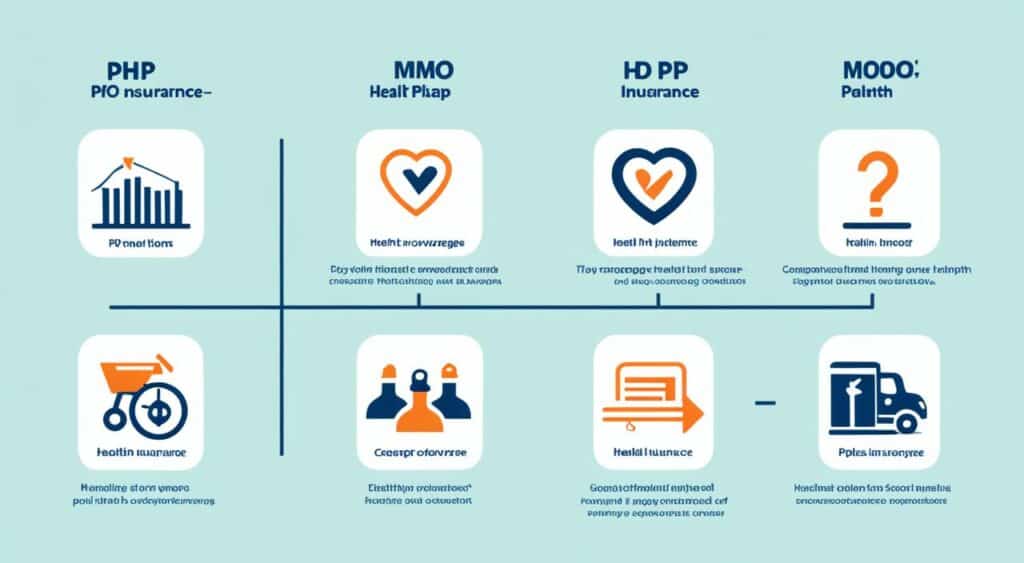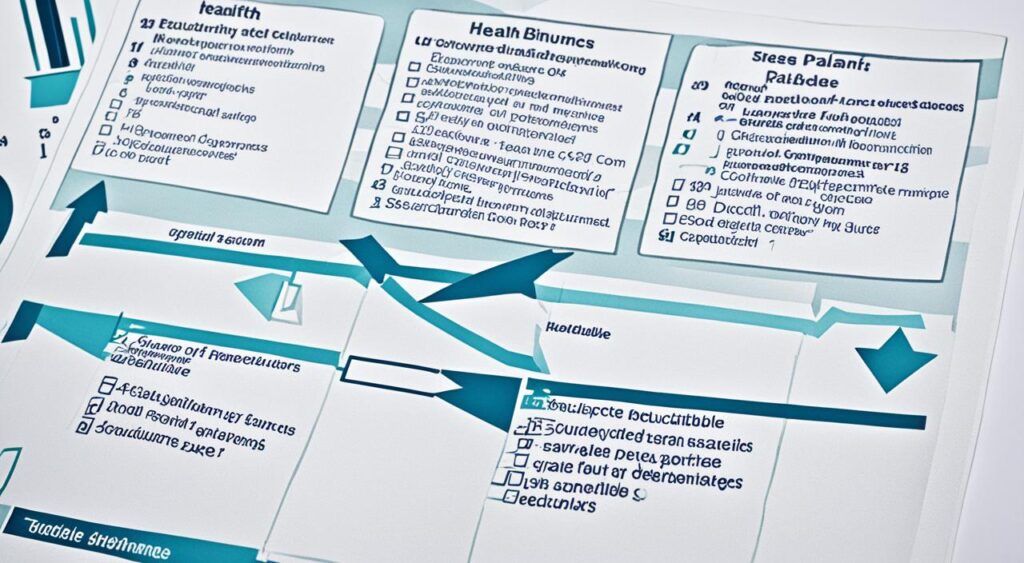Finding the right health insurance for your family is key to good health care. With many options from the Affordable Care Act, picking the right one can feel hard. This guide will make it easier to choose the best plan for your family.
Key Takeaways
- Understand the different health insurance marketplaces and whether your employer offers coverage
- Compare the types of health insurance plans, including HMOs, PPOs, EPOs, and POSs
- Evaluate your family’s medical needs and choose a plan that meets those requirements
- Explore high-deductible health plans and their potential benefits
- Analyze the health plan networks and choose one that includes your preferred doctors
Choose Your Health Insurance Marketplace
Choosing a family health insurance plan starts with picking a marketplace. If your job offers health insurance, you can sign up through them. This is usually cheaper than buying on your own. But, if your job doesn’t offer coverage, you’ll look at the individual marketplace.
You can check the state exchange or HealthCare.gov for plans. Buying directly from a company is another option, but you won’t get premium help.
If Your Employer Offers Health Insurance
Employer health insurance is often the best deal for families. Companies often pay part of the premiums, making it cheaper for you. These plans also offer more coverage and better benefits than individual plans.
If Your Employer Doesn’t Offer Health Insurance
If your job doesn’t have health insurance, you’ll look at the individual marketplace. You can use your state’s exchange or HealthCare.gov. These places have many plans from private companies, and you might get help with costs.
Finding the right health insurance can seem hard, but knowing your options is key. Think about your job’s plans, the individual marketplace, and what you need for health care. This way, you can choose the best coverage for your family.
Compare Types of Health Insurance Plans

Choosing the right health insurance plan for your family is key. You’ll find four main types: HMOs, PPOs, EPOs, and POS plans. Each has its own set of features, network rules, and costs. These can greatly affect your healthcare experience and what you pay.
HMO vs. PPO vs. EPO vs. POS
HMOs are known for their low costs but come with some limits. You must use doctors in their network and get a referral to see specialists. PPOs let you see both in-network and out-of-network doctors, but at a higher cost. EPOs are like HMOs but you don’t need a referral for specialists. POS plans mix HMO and PPO benefits, offering flexibility and network coverage.
Look for a Summary of Benefits
When looking at health insurance plans, check the summary of benefits for each. This document details coverage, including the provider network, out-of-pocket costs, and services covered. Knowing these details helps you pick a plan that meets your family’s health needs and budget.
| Plan Type | Network Restrictions | Out-of-Pocket Costs | Referrals Required |
|---|---|---|---|
| HMO | Strict in-network | Lowest | Yes |
| PPO | More flexible, in and out-of-network | Higher | No |
| EPO | Strict in-network, but may not require referrals | Moderate | No |
| POS | Combination of in-network and out-of-network | Moderate | Depends on plan |
“Understanding the differences between HMOs, PPOs, EPOs, and POS plans can help you choose the right family health insurance coverage that fits your budget and healthcare needs.”
Weigh Your Family’s Medical Needs
Choosing the right health insurance plan means looking at your family’s health history and future needs. Think about the care your family has used in the past. This includes doctor visits, specialist care, emergency services, and ongoing treatments for chronic conditions. This will help you pick the right coverage and understand your out-of-pocket costs.
Also, consider any future medical needs, like pregnancies or surgeries. Think about how much preventive care your family needs. Knowing your family’s health care utilization helps you choose the best family medical needs insurance plan.
| Medical Needs | Frequency | Estimated Costs |
|---|---|---|
| Primary Care Visits | 4 per year | $200 per visit |
| Specialist Appointments | 2 per year | $150 per visit |
| Emergency Care | 1 visit per year | $1,500 per visit |
| Chronic Condition Management | Monthly medication and quarterly checkups | $500 per month |
By thinking about your family’s medical needs, you can pick a health insurance plan that covers what you need. This way, you can also keep your expected medical expenses down.
Understand Referral Requirements

When picking a family health insurance plan, knowing about referral needs is key. Some plans, like HMOs and POS, need a referral from your primary doctor to see a specialist. This helps plan your care but limits your choice of doctors.
Plans That Require Referrals
HMO and POS plans need a referral to see a specialist. This makes sure your care is well-planned and right for you. But, it means you can’t just pick any doctor you want, as you must stay within the plan’s network.
Plans That Don’t Require Referrals
PPO and EPO plans don’t need referrals to see specialists. This lets you choose your doctors more freely, even those outside the network. But, seeing doctors outside the network might cost you more.
When looking at health insurance plans, think about what your family needs for healthcare. If you like having your care planned out, an HMO or POS might be best. If you want to pick your doctors more easily, a PPO or EPO could work better.
| Plan Type | Referral Requirements | Network Flexibility | Out-of-Pocket Costs |
|---|---|---|---|
| HMO | Referral required | Limited to in-network providers | Lower |
| POS | Referral required | More flexibility, but higher costs for out-of-network providers | Moderate |
| PPO | No referral required | More flexibility, but higher costs for out-of-network providers | Higher |
| EPO | No referral required | Limited to in-network providers | Moderate |
Knowing about referral needs in health insurance plans helps you choose wisely. It ensures your family’s healthcare needs and preferences are met.
Explore High-Deductible Health Plans

Choosing a family health insurance plan? Consider high-deductible health plans (HDHPs). They have lower monthly premiums but you pay more before coverage starts.
HDHPs let you open a tax-advantaged health savings account (HSA). An HSA is for setting aside pre-tax dollars for medical costs like deductibles and prescription drugs. This can help cover the higher costs of an HDHP.
HDHPs also cover preventive care before you meet your deductible. So, you can get routine check-ups and screenings without paying the full cost.
But, think about your family’s health needs before picking an HDHP. These plans might not work well if you or your family needs a lot of medical care. In that case, a plan with a lower deductible might be better.
Choosing an HDHP depends on your family’s health needs, budget, and goals. Knowing the pros and cons helps you pick the right balance of out-of-pocket costs and catastrophic coverage.
Compare Health Plan Networks
Choosing a family health insurance plan means looking at the provider network. This network shows which doctors, hospitals, and other healthcare places you can visit at a lower cost. Using providers outside this network can lead to higher out-of-pocket costs.
Why Does the Network Matter?
The size and type of providers in a plan’s network affect your healthcare costs and experience. In-network providers charge less for services like doctor visits and hospital stays. But, out-of-network providers might charge more, making you pay more too.
Do You Have Preferred Doctors?
If you already see certain doctors for your family’s health, make sure they’re in the plan’s network. This way, you can keep seeing your trusted doctors without paying more.
Living in a rural area also matters. A big network means you can find local doctors easily and won’t have to travel far for care.
| Plan Feature | In-Network Care | Out-of-Network Care |
|---|---|---|
| Annual Deductible | $500 | $1,000 |
| Coinsurance Rate | 20% | 40% |
| Maximum Out-of-Pocket | $3,000 | $6,000 |
Choosing out-of-network care can raise your out-of-pocket costs a lot. It’s key to check the network and preferred providers when picking a health insurance plan for your family.
Family Health Insurance: Compare Out-of-Pocket Costs
Choosing the right family health insurance plan means looking at more than just the monthly costs. You need to think about deductibles, copays, coinsurance, and the out-of-pocket maximum. Knowing these costs helps you pick a plan that fits your family’s health needs and budget.
Plans with higher monthly premiums usually have lower out-of-pocket costs. On the other hand, plans with lower premiums might have higher out-of-pocket expenses. Think about how much healthcare your family will use and find the right balance between premium and out-of-pocket costs. Also, check the plan’s out-of-pocket maximum to know your total healthcare costs for the year.
When looking at health insurance out-of-pocket costs, consider these key factors:
- Deductibles: This is the amount you pay before your insurance kicks in.
- Copays: A fixed amount you pay for things like doctor visits or prescriptions.
- Coinsurance: The percentage of costs you pay for services after meeting your deductible.
- Out-of-Pocket Maximum: The most you’ll pay for healthcare in a year, after which your plan covers 100% of costs.
Understanding these costs and how they fit into your healthcare budgeting helps you choose the best health insurance plan for your family.
“Careful consideration of out-of-pocket costs can help you find the right balance between premium and coverage for your family’s healthcare needs.”
Also Read : Choosing The Best Health Insurance Plans For Your Needs
Compare Plan Benefits

When picking a family health insurance plan, look beyond just the monthly costs and deductibles. Check the range of services covered to make sure your family’s health needs are met. Look at the benefits of different plans, focusing on preventive care, mental health care, prescription drug coverage, emergency care, maternity care, fertility treatment, and physical therapy.
Check the Scope of Services
Some health insurance plans offer more coverage for services your family needs. For example, one plan might have better mental health care benefits, while another covers fertility treatments well. Look at the benefits summary for each plan to see what services are included.
- Check the plan’s preventive care coverage, like annual checkups and screenings.
- Look at the plan’s prescription drug coverage, including copays and limits.
- See what the plan covers for emergency care, like ambulance and ER visits.
- Find out about the plan’s maternity care services, from prenatal to postpartum.
- See what the plan covers for physical therapy and rehabilitation services.
| Benefit | Plan A | Plan B | Plan C |
|---|---|---|---|
| Preventive Care | 100% covered | 80% covered | 100% covered |
| Mental Health Care | $20 copay per visit | $30 copay per visit | 90% covered |
| Prescription Drugs | $10/$30/$50 copays | $15/$40/$60 copays | $5/$25/$45 copays |
| Emergency Care | $150 copay | $200 copay | 90% covered |
| Maternity Care | 90% covered | 80% covered | 100% covered |
| Fertility Treatment | Not covered | $5,000 lifetime max | $10,000 lifetime max |
| Physical Therapy | $30 copay per visit | $40 copay per visit | 90% covered |
By looking at the services each plan covers, you can choose the best one for your family’s health needs and preferences.
Conclusion
Choosing the right health insurance for your family is very important. It affects your health and money. Knowing about different plans like HMOs, PPOs, EPOs, and POS plans helps you pick the best one for your family’s health needs.
Look at things like provider networks, costs, and services offered by plans. Think about if you need referrals and learn about high-deductible plans. These plans can save money but still cover a lot.
Do your homework on all your options, including the Health Insurance Marketplace if your job doesn’t offer insurance. Making a smart choice about health insurance means your family gets the care they need without breaking the bank. The right plan gives you peace of mind and makes sure your family is taken care of.
FAQs
Q: How do I choose the right family health insurance plan?
A: When choosing a family health insurance plan, consider factors such as your family’s healthcare needs, budget, preferred doctors and hospitals, coverage options, and if the plan complies with the Affordable Care Act. It’s advisable to compare different plans, explore coverage options, and seek advice from an insurance company or agent to find a plan that best suits your family.
Q: What are the differences between individual and family health insurance plans?
A: Individual health insurance plans usually cover one person, while family health insurance plans provide coverage for multiple family members under one policy. Family plans may offer cost savings compared to purchasing individual plans for each family member.
Q: How can I explore health insurance options in my area?
A: To explore health insurance options in your area, you can visit insurance company websites, use online insurance marketplaces, contact insurance agents, or utilize resources provided by organizations like Florida Blue. You can also compare plan options, coverage benefits, and premiums to make an informed decision.
Q: What is virtual care, and does it come with family health insurance plans?
A: Virtual care allows individuals to consult with healthcare providers remotely through video calls or online messaging. Some family health insurance plans may include virtual care services, which can provide convenient access to medical consultations, especially for non-emergency issues.
Q: How do I find individual and family insurance plans that are affordable?
A: To find affordable individual and family insurance plans, you can compare premiums, coverage benefits, deductibles, and out-of-pocket costs. Additionally, you can check if you qualify for subsidies or tax credits through the Affordable Care Act to reduce the cost of your health insurance.
Q: What role does Medicare play in choosing a family health insurance plan?
A: If you or a family member is eligible for Medicare, it’s important to consider how Medicare coverage aligns with your family health insurance plan. Understanding the enrollment periods, benefits, and potential coordination of benefits between Medicare and your chosen family health insurance plan is crucial for comprehensive health coverage.
Q: How do I ensure that I choose the right health insurance plan that meets my family’s needs?
A: To choose the right health insurance plan for your family, carefully evaluate factors such as network coverage, prescription drug coverage, provider networks, premiums, deductibles, and out-of-pocket costs. Additionally, consider seeking advice from insurance experts or utilizing tools provided by insurance companies to customize a plan that aligns with your family’s health needs.
Source Links
- https://www.healthcare.gov/choose-a-plan/
- https://www.usbank.com/financialiq/plan-your-future/health-and-wellness/steps-to-choosing-a-health-insurance-plan.html
- https://www.nerdwallet.com/article/health/choose-health-insurance




